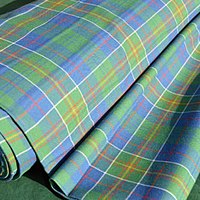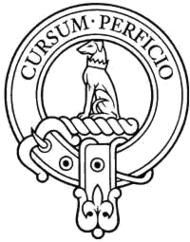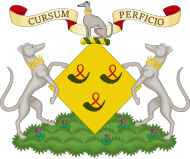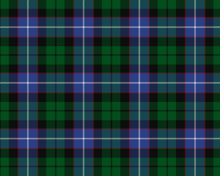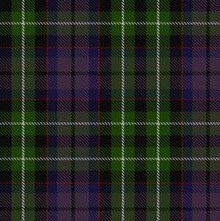
Tartan is a patterned cloth with crossing horizontal and vertical bands in multiple colours, forming simple or complex rectangular patterns. Tartans originated in woven wool, but are now made in other materials. Tartan is particularly associated with Scotland, and Scottish kilts almost always have tartan patterns. The earliest surviving samples of tartan-style cloth are around 3,000 years old and were discovered in Xinjiang, China.

Clan MacLeod is a Highland Scottish clan associated with the Isle of Skye. There are two main branches of the clan: the MacLeods of Harris and Dunvegan, whose chief is MacLeod of MacLeod, who are known in Gaelic as Sìol Tormoid ; the Clan MacLeod of Lewis and Raasay, whose chief is MacLeod of The Lewes, are known in Gaelic as Sìol Torcaill. Both branches claim descent from Leòd, a Norse-Gael who lived in the 13th century.

Clan Arbuthnott is a Lowland Scottish clan.

Clan Nesbitt is a Scottish clan of the Scottish Borders that is recognised by the Lord Lyon King of Arms.

The origins of Clan MacCulloch are unknown, but there is a consensus that the family was one of the most ancient families of Galloway, Scotland, and a leading medieval family in that region. Despite the obscurity of the early history of the clan, the history and genealogies of the family are well documented in Walter Jameson McCulloch's History of the Galloway Families of McCulloch, which provides extensive footnotes for original Scottish charters, correspondence, and other primary source documentation. The latter provides family history for the following lines: Myretoun, Ardwell, Killasser, Torhouse, Drummorrell, Inshanks and Mule, Torhousekie, Cardiness, Barholm, Kirkclaugh, Auchengool, and Ardwall.

Clan Logan is a very ancient Scottish clan of Celtic origin. Two distinct branches of Clan Logan exist: the Highland branch; and the Lowland branch. The clan does not have a chief recognised by Lord Lyon King of Arms, and therefore can be considered an armigerous clan.

Clan Maclachlan, also known as Clan Lachlan, Clann Lachainn (Argyll), and Clann Lachlainn, is a Highland Scottish clan that historically centred on the lands of Strathlachlan on Loch Fyne, Argyll on the west coast of Scotland. The clan claims descent from Lachlan Mor, who lived on Loch Fyne in the 13th century, and who has left his name upon the countryside he once controlled: places such as Strathlachlan, Castle Lachlan and Lachlan Bay. Tradition gives Lachlan Mor a descent from an Irish prince of the O'Neill dynasty, Ánrothán Ua Néill, son of Áed, son of Flaithbertach Ua Néill, King of Ailech and Cenél nEógain, died 1036. Clan Maclachlan has been associated with other clans, such as Clan Lamont, Clan Ewen of Otter, Clan MacNeil of Barra, and the MacSweens: as all claim descent from Anrothan O'Neill who left Ireland for Kintyre in the 11th century. From this descent the clan claims a further descent from the legendary Niall Noigíallach, High King of Ireland, who lived from the mid 4th century to the early 5th century.

Clan MacDowall or MacDouall is a Lowlands Scottish clan.

Clan MacLennan, also known as Siol Ghillinnein, is a Highland Scottish clan which historically populated lands in the north-west of Scotland. The surname MacLennan in Scottish Gaelic is Mac Gille Fhinnein, meaning the son of the follower of St Finnan.

Clan Irvine is a Scottish clan.

Clan Spens or Spence is a Lowland Scottish clan and is also a sept of Clan MacDuff.

Clan MacAulay, also spelt Macaulay or Macauley is a Scottish clan. The clan was historically centred on the lands of Ardincaple, which are today consumed by the little village of Rhu and burgh of Helensburgh in Argyll and Bute. The MacAulays of Ardincaple were located mainly in the traditional county of Dunbartonshire, which straddles the "Highland Line" between the Scottish Highlands and Lowlands. Clan MacAulay has been considered a "Highland clan" by writers and has been linked by various historians to the original Earls of Lennox and in later times to Clan Gregor. The MacAulays of Ardincaple, like Clan Gregor and several other clans, have traditionally been considered one of the seven clans which make up Siol Alpin. This group of clans were said to have claimed descent from Cináed mac Ailpín, King of the Picts, from whom later kings of Scotland traced their descent. The chiefs of Clan MacAulay were styled Laird of Ardincaple.

Clan Muir is a Scottish clan that is armigerous. Per certain sources, holders of the surname Muir, of Ayrshire, have been noted as a possible sept of Clan Boyd, though this is not clearly identified to a reliable resource. A spelling variation More/Moore is a sept of Clan Leslie in Aberdeenshire, and, having genetic proof of Muirs in Aberdeenshire, may have roots in the Mure/Muir line of southwest Scotland.

Clan Galbraith is a Scottish clan. The clan does not have a chief recognised by the Lord Lyon King of Arms. Because of this, the clan is considered an armigerous clan, and as such Clan Galbraith has no standing under Scots Law. The clan-name of Galbraith is of Gaelic origin, however its meaning denotes the bearer as of Brythonic origin, as opposed to Gaelic. The early Galbraiths were centred in the Lennox district, which spans the Highland and Lowland border of Scotland. The 17th chief of the clan brought ruin to the clan in the late 16th and early 17th century, and eventually lost his lands and fled Scotland for Ireland. His grandson, the 19th chief, was the last chief of Clan Galbraith.
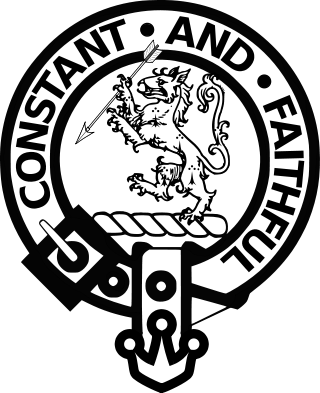
Clan Macqueen is a Highland Scottish clan and a member of the Chattan Confederation. The clan does not currently have a chief and is therefore considered an armigerous clan.

Clan Crawford is a Scottish clan of the Scottish Lowlands. The clan is of Scandinavian and Anglo-Saxon origin. There was in the early 18th century a mistaken belief that the clan had Norman origins. While historically recognised as a clan by the Court of the Lord Lyon, it is now an armigerous clan as it no longer has a chief. The last chief was Hugh Ronald George Craufurd, who sold his land and moved to Canada in 1904. He died in Calgary in 1942, leaving no male heirs.

Clan Innes is a Highland and Lowland Scottish clan. The clan takes its name from the lands of Innes in Moray, Scotland. The de facto chief of the clan is the Duke of Roxburghe, directly descended in the male line from the Innes Baronets, chiefs of the name.

Clan Little is a Scottish clan of the Borders. The clan does not currently have a chief and is therefore considered an armigerous clan. The Clan Little Society had a Guardian in place of a clan chief but, since his death in 2007, no suitable successor has appeared.
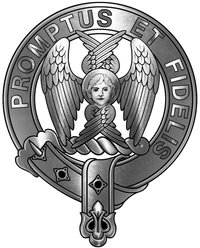
Carruthers, a Scottish Lowland clan and family from Annandale in Dumfriesshire.
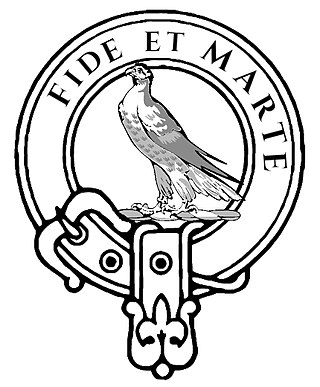
Clan Ralston is a Scottish clan. The clan is recognized as such by the Court of the Lord Lyon, but as it does not currently have a chief recognized by the Lord Lyon King of Arms it is considered an Armigerous clan.
